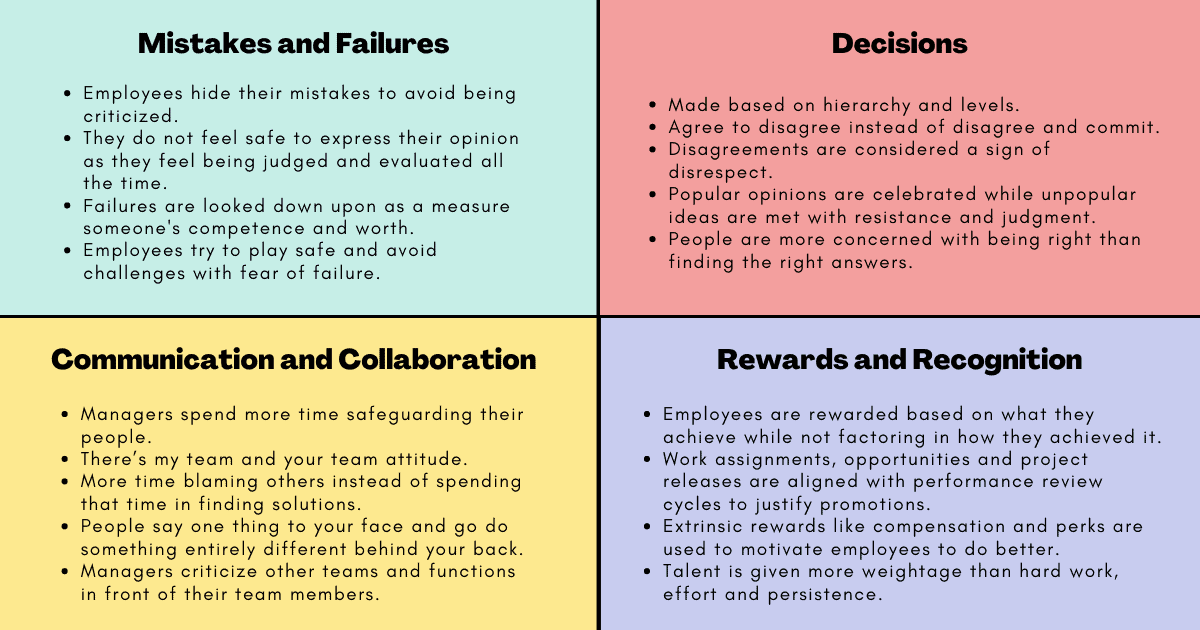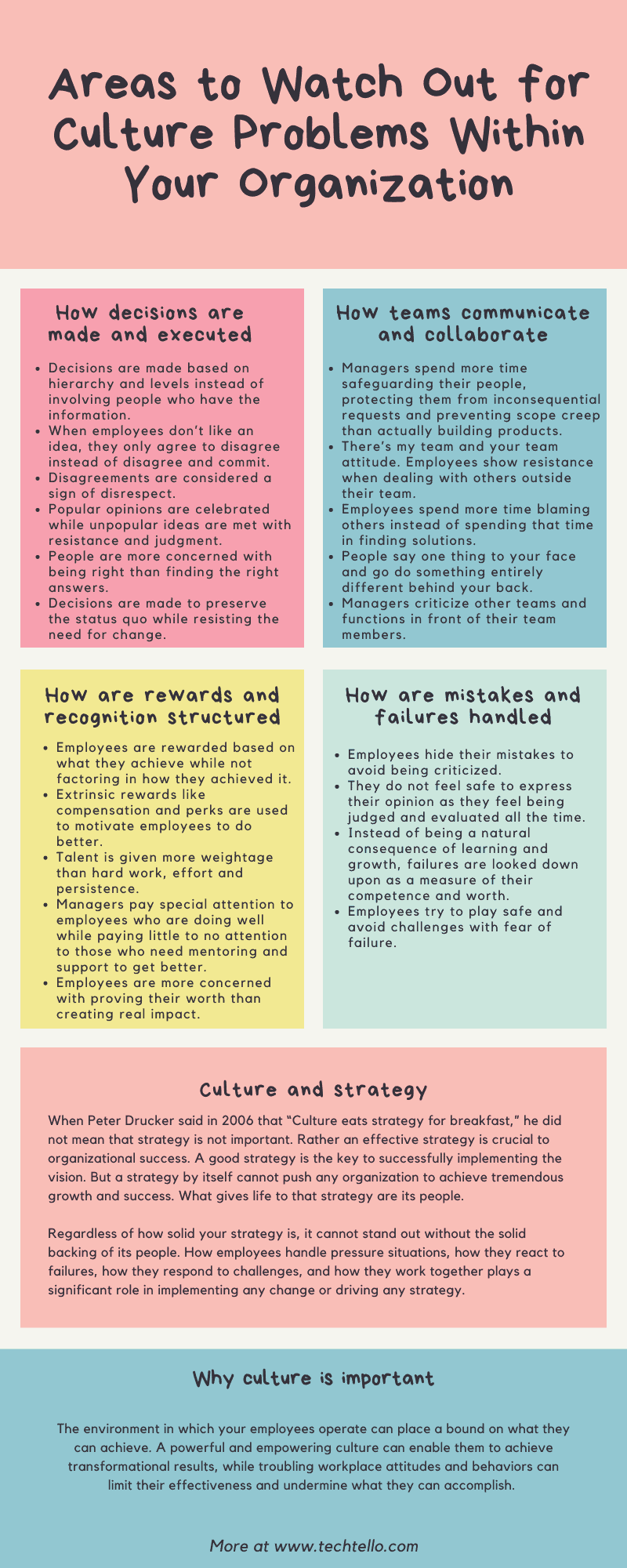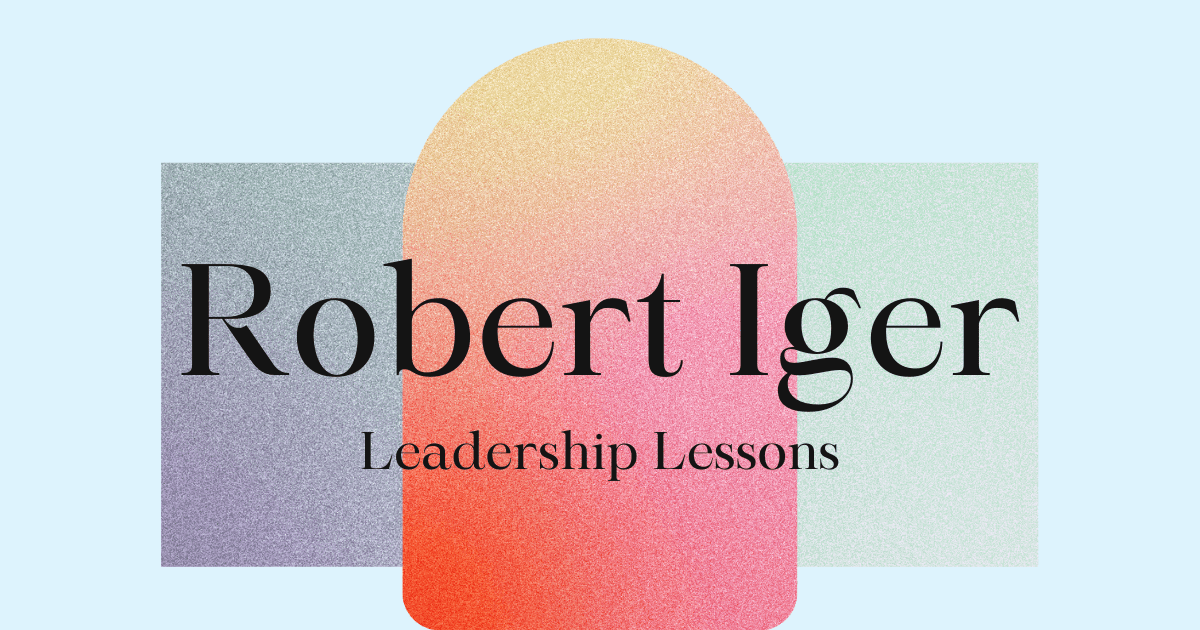Culture of an Organization: Subtle Culture Problems That Often Go Unnoticed

When Peter Drucker said in 2006 that “Culture eats strategy for breakfast,” he did not mean that strategy is not important. Rather an effective strategy is crucial to organizational success. A good strategy is the key to successfully implementing the vision. But a strategy by itself cannot push any organization to achieve tremendous growth and success. What gives life to that strategy are its people.
Regardless of how solid your strategy is, it cannot stand out without the solid backing of its people. How employees handle pressure situations, how they react to failures, how they respond to challenges, and how they work together plays a significant role in implementing any change or driving any strategy.
The environment in which your employees operate can place a bound on what they can achieve. A powerful and empowering culture can enable them to achieve transformational results, while troubling workplace attitudes and behaviors can limit their effectiveness and undermine what they can accomplish.
Your culture is the landscape on which you execute your strategy. Just like a group of mountaineers cannot reach the top of the mountain without a good strategy and support from each other, a company cannot achieve success without aligning strategy with people who must work together to make it possible. Instead of letting your employees struggle through navigating difficult terrains, make it easy for them to enjoy the ride.
Louis Gerstner, former CEO of IBM writes in Who Says Elephants Can’t Dance “Until I came to IBM, I probably would have told you that culture was just one among several important elements in any organization’s makeup and success—along with vision, strategy, marketing, financials, and the like…I came to see, in my time at IBM, that culture isn’t just one aspect of the game—it is the game. In the end, an organization is nothing more than the collective capacity of its people to create value…You can quickly figure out, sometimes within hours of being in a place, what the culture encourages and discourages, rewards and punishes. Is it a culture that rewards individual achievement or team play? Does it value risk taking or consensus building?”
If you are committed to strengthening your culture that leads to growth, watch out for these four areas in which your organization may have a subtle culture problem.
4 areas to watch out for culture problems within your organization
1. How decisions are made and executed
Good decision making is a key element in any organization’s effectiveness. How decisions are made not only impacts the outcome, it also impacts the culture of your organization.
Your organization has a culture problem when:
- Decisions are made based on hierarchy and levels instead of involving people who have the information.
- When employees don’t like an idea, they only agree to disagree instead of disagree and commit. This makes them work against the idea trying to sabotage it at all times only to prove their point “I said so.”
- Disagreements are considered a sign of disrespect.
- People are more concerned with being right than finding the right answers.
- Popular opinions are celebrated while unpopular ideas are met with resistance and judgment.
- Decisions are made to preserve the status quo while resisting the need for change.
Reed Hastings writes in No Rule Rules “In a fast and innovative company, ownership of critical, big-ticket decisions should be dispersed across the workforce at all different levels, not allocated according to hierarchical status. When you give low-level employees access to information that is generally reserved for high-level executives, they get more done on their own. They work faster without stopping to ask for information and approval. They make better decisions without needing input from the top…If you give employees more freedom instead of developing processes to prevent them from exercising their own judgment, they will make better decisions and it’s easier to hold them accountable.”
By empowering people to make decisions, you can shift the culture of the organization from relying on hierarchies and levels to encouraging knowledge and experience in the decision process.
2. How teams communicate and collaborate
A large amount of work in organizations requires collaborating across multiple teams and functions. How people work together across teams not only has a major impact on effort, timeline, and resources required to complete a project, it also reflects on the culture of your organization.
Your organization has a culture problem when:
- Managers spend more time safeguarding their people, protecting them from inconsequential requests and preventing scope creep than actually building products.
- There’s my team and your team attitude. Employees feel superior about their own team and work while showing resistance when dealing with others outside their team.
- Employees spend more time blaming others instead of spending that time in finding solutions.
- People say one thing to your face and go do something entirely different behind your back.
- Managers criticize other teams and functions in front of their team members. They talk about how others are incompetent while praising their team for doing everything right.
Patrick Lencioni writes in The Five Dysfunctions Of A Team “Not finance. Not strategy. Not technology. It is teamwork that remains the ultimate competitive advantage, both because it is so powerful and so rare…If you could get all the people in an organization rowing in the same direction, you could dominate any industry, in any market, against any competition, at any time.”
By including healthy collaboration practices and reinforcing the value of working together, you can shift the culture of the organization from relying on blames and excuses to taking responsibility and collaborating effectively as a team.
3. How are rewards and recognition structured
Organizations rely on rewarding employees to motivate them to produce better results. But, how these rewards are structured significantly impact the culture of an organization.
Your organization has a culture problem when:
- Employees are rewarded based on what they achieve while not factoring in how they achieved it. Bad behavior is ignored as long as outcomes are achieved.
- Work assignments, opportunities and project releases are aligned with performance review cycles to justify promotions.
- Extrinsic rewards like compensation and perks are used to motivate employees to do better.
- Talent is given more weightage than hard work, effort and persistence.
- Managers pay special attention to employees who are doing well while paying little to no attention to those who need mentoring and support to get better.
- Employees are more concerned with proving their worth than creating real impact. They spend significant time and energy in managing other people’s impressions of them.
- Time spent in the office is valued more than time spent creating value.
Daniel Pink writes in Drive “Rewards can perform a weird sort of behavioral alchemy: They can transform an interesting task into a drudge. They can turn play into work. And by diminishing intrinsic motivation, they can send performance, creativity, and even upstanding behavior toppling like dominoes.”
By paying special attention to the behaviors and actions that are rewarded, you can shift the culture of the organization from relying on external motivators to tapping into the intrinsic motivation of your employees to achieve better outcomes.
4. How are mistakes and failures handled
Even with the best of intentions, mistakes and failures do happen. How mistakes and failures are handled impact the culture of an organization.
Your organization has a culture problem when:
- Employees hide their mistakes to avoid being criticized.
- They do not feel safe to express their opinion as they feel being judged and evaluated all the time.
- Instead of being a natural consequence of learning and growth, failures are looked down upon as a measure of their competence and worth.
- Employees try to play safe and avoid challenges with fear of failure.
Amy Edmondson writes in The Fearless Organization “Fear inhibits learning…It’s hard for people to do their best work when they are afraid. As a result, how psychologically safe a person feels strongly shapes the propensity to engage in learning behaviors, such as information sharing, asking for help, or experimenting. In psychologically safe environments, people believe that if they make a mistake or ask for help, others will not react badly. Instead, candor is both allowed and expected. Psychological safety exists when people feel their workplace is an environment where they can speak up, offer ideas, and ask questions without fear of being punished or embarrassed. Is this a place where new ideas are welcomed and built upon? Or picked apart and ridiculed? Will your colleagues embarrass or punish you for offering a different point of view? Will they think less of you for admitting you don’t understand something?”
By using failures and mistakes as valuable learning opportunities within the organization, you can shift the culture of the organization from taking failures personally to considering them as an essential element of growth.
Summary
- An organization cannot rely on strategy alone to achieve success. It needs a strong culture to make that strategy effective.
- The culture of an organization feeds into its employees’ effectiveness. A powerful culture can enable employees to achieve excellence while a wrong culture can limit what they can accomplish.
- How decisions are made impact the culture of your organization. Your organization is a cultural risk when hierarchies and levels are given more importance than people with knowledge and experience.
- How employees collaborate across teams also play a significant role in shaping the culture of your organization. A cultural crisis may be looming when blames and excuses are used to protect team boundaries.
- There’s nothing wrong with appreciating people for their work and contribution. However, your culture is at risk when extrinsic rewards are used as a powerful motivator to get work done.
- Your organization definitely has a culture problem when employees do not feel safe to express their opinion or hide their mistakes with fear of being judged and criticized. They refuse to take challenges and ignore opportunities with a fear that a failure will reflect on their competence.






























